ELNA 2800 User Manual
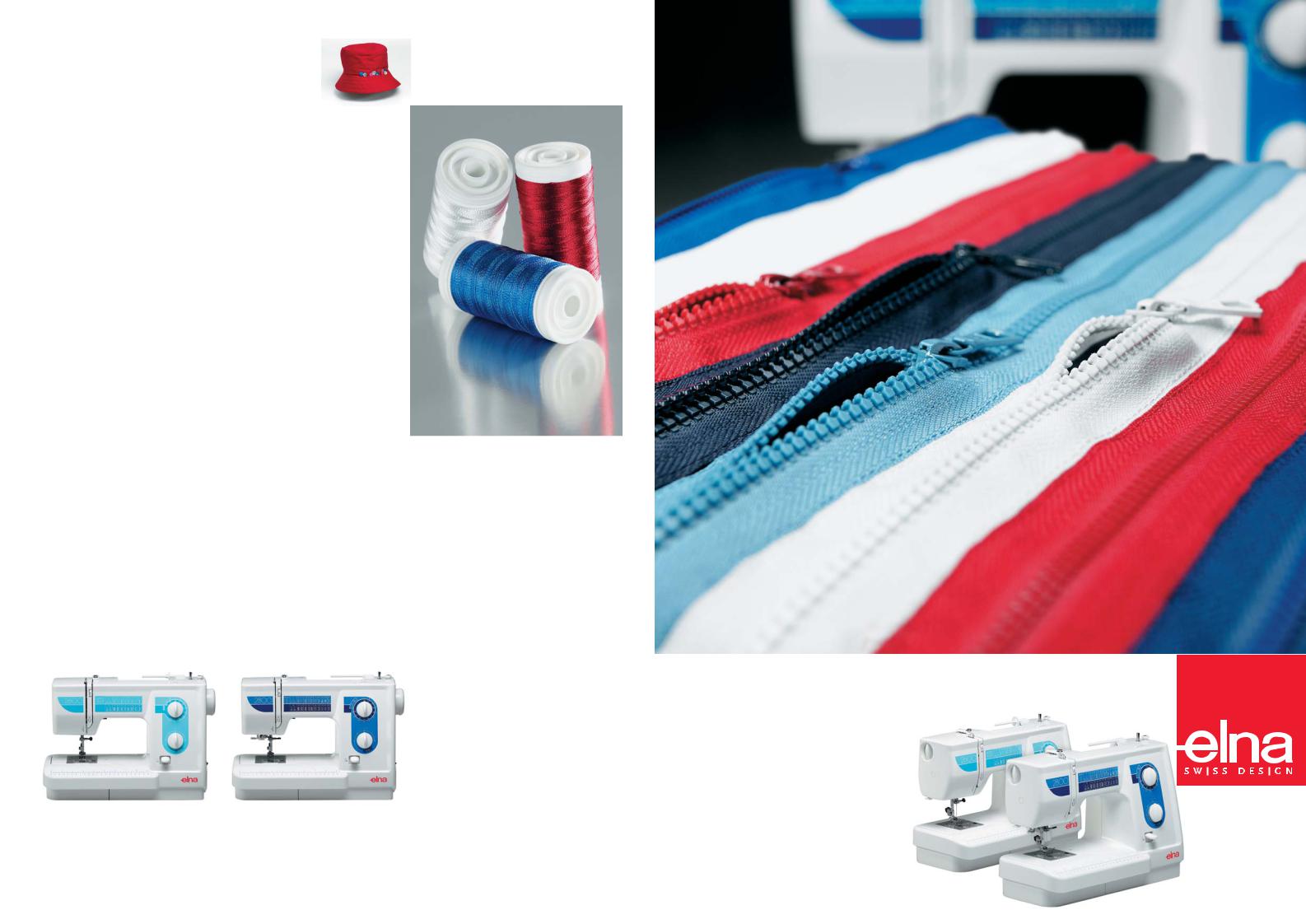
2600-2800
INSTRUCTIONS MANUAL
IMPORTANT SAFETY INSTRUCTIONS
Your Elna 2600/2800 series sewing machine is designed and constructed for HOUSEHOLD use only. Read all instructions before using this machine.
DANGER – To reduce the risk of electric shock:
1.Your sewing machine should never be left unattended when plugged in. Always unplug the machine from the electrical outlet immediately after using and before cleaning.
2.Always unplug before replacing light bulb. Replace bulb with same bayonet socket type, 15W max.
3.Do not place or store machine where it can fall or be pulled into a tub or sink. Do not reach for the machine if it has fallen into water. Unplug immediately.
WARNING – To reduce the risk of burns, fire, electrical shock or injury:
1.Do not allow machine to be used as a toy. Supervision is necessary when this machine is used by or near children.
2.Use this sewing machine only for its intended use as described in this manual. Only use attachments recommended by the manufacturer as described in this manual.
3.Never operate this machine if it has a damaged cord or plug, is not working properly, has been dropped or damaged or dropped into water. Return the machine to the nearest authorized dealer or service center for examination, repair, electrical or mechanical adjustment.
4.This machine is equipped with a special connection cord which, if damaged, must be replaced by an identical cord. This can be obtained from your dealer.
5.Never operate the sewing machine with any air opening blocked. Keep ventilation openings of the sewing machine and foot control free from the accumulation of lint, dust and fibers.
6.Never drop or insert any object into any opening.
7.Do not use outdoors.
8.Do not operate where aerosol (spray) products are being used or where oxygen is being administered.
9.To disconnect, turn machine off and remove plug from outlet.
10.Do not unplug by pulling on cord. To unplug, grasp the plug, not the cord.
11.Keep fingers away from all moving parts, especially the needle.
12.Always use the proper needle plate. The wrong plate can cause the needle to break.
13.Do not use bent needles.
14.Do not pull or push fabric while stitching. This may deflect the needle causing it to break.
15.Switch the sewing machine off when making any adjustment in the needle area, such as threading needle, changing needle, threading bobbin, changing presser foot, etc.
16.Always unplug the sewing machine from the electrical outlet when removing covers, lubricating or making any other servicing adjustments mentioned in the instruction manual.
SAVE THESE INSTRUCTIONS
USA only
Your machine comes equipped with a polarized plug (one prong wider than the other). A polarized plug reduces the risk of electrical shock. This plug is intended to fit into a polarized outlet. If the plug does not fit
fully into the outlet, reverse the plug. If it still does not fit, contact a qualified electrician to install the proper outlet. Do not modify the plug in any way.
Use only foot control YC-482J or TJC-150 (UL, CSA).
TABLE OF CONTENTS
SECTION 1. KNOW YOUR MACHINE |
|
Names of Parts .............................................................. |
2 |
Standard Accessories .................................................... |
3 |
Accessory Storage ......................................................... |
3 |
Extension Table ............................................................. |
4 |
Free Arm Sewing ........................................................... |
4 |
SECTION 2. GETTING READY TO SEW |
|
Connecting the Power Supply ....................................... |
5 |
Controlling the Sewing Speed ....................................... |
5 |
Reverse Stitch Lever ..................................................... |
6 |
Foot Pressure Dial ......................................................... |
6 |
Dropping the Feed Dog ................................................. |
6 |
Raising and Lowering the Presser Foot ........................ |
7 |
Changing the Presser Foot ............................................ |
7 |
Removing and Attaching the Shank .............................. |
7 |
Changing Needles ......................................................... |
8 |
Needle and Fabric Chart ................................................ |
8 |
Winding the Bobbin ................................................... |
9-10 |
Setting the spool ............................................................ |
9 |
Additional spool pin ........................................................ |
9 |
Removing the bobbin ..................................................... |
9 |
Inserting the bobbin ..................................................... |
11 |
Threading the Machine ................................................ |
12 |
Needle threader ........................................................... |
13 |
Drawing up the Bobbin Thread .................................... |
14 |
Selecting a Stitch ......................................................... |
15 |
Stitch selector dial ........................................................ |
15 |
Stitch Length Dial ......................................................... |
15 |
Fine Tuning Stretch Stitches ....................................... |
16 |
Stitch Width Dial .......................................................... |
16 |
Variable needle position .............................................. |
16 |
Balancing Needle Thread Tension .............................. |
17 |
SECTION 3. BASIC SEWING |
|
SECTION 4. UTILITY STITCHES |
|
Basic Zigzag ................................................................ |
20 |
Overcasting .................................................................. |
20 |
Super Stretch Stitch ..................................................... |
21 |
3-Step Zigzag............................................................... |
21 |
Triple Seam.................................................................. |
22 |
Rickrack or Triple Zigzag ............................................. |
22 |
Button Sewing .............................................................. |
23 |
Automatic Buttonhole (Model 2800) ....................... |
24-26 |
Adjusting the buttonhole stitch density ............................. |
26 |
4-step Buttonhole (Model 2600) .................................. |
27 |
Adjusting the buttonhole stitch density ............................. |
27 |
Corded Buttonhole (Model 2800) ................................ |
28 |
Corded Buttonhole (Model 2600) ................................ |
29 |
Manual Buttonhole (Model 2800) ................................ |
30 |
Zipper Application ........................................................ |
31 |
Blind Hem Stitches ...................................................... |
34 |
SECTION 5. DECORATIVE STITCHES |
|
Decorative Satin Stitches............................................. |
35 |
Decorative Stretch Stitches ......................................... |
35 |
Smocking ..................................................................... |
36 |
Quilt Guide (Model 2800)............................................. |
37 |
Pintucks ....................................................................... |
38 |
Shell Tuck .................................................................... |
38 |
Fagoting ....................................................................... |
39 |
Patchwork .................................................................... |
39 |
Satin Stitch Appliqué.................................................... |
40 |
SECTION 6. CARE AND MAINTENANCE |
|
Cleaning the Hook Race and Feed Dog ...................... |
41 |
Replacing the Bobbin Case ......................................... |
42 |
Replacing the Light Bulb .............................................. |
42 |
Troubleshooting ........................................................... |
43 |
Straight Stitch Sewing.................................................. |
18 |
Changing the sewing direction .................................... |
18 |
Finishing sewing .......................................................... |
18 |
Seam guides on the needle plate ................................ |
19 |
Turning a square corner .............................................. |
19 |
OPTIONAL ACCESSORIES ........................ |
44 |
RECYCLING REGULATIONS ...................... |
44 |
NOTE: Information found in this instruction manual is current at the time of printing. Elna reserves the right to change and update specifications and information as needed.
1
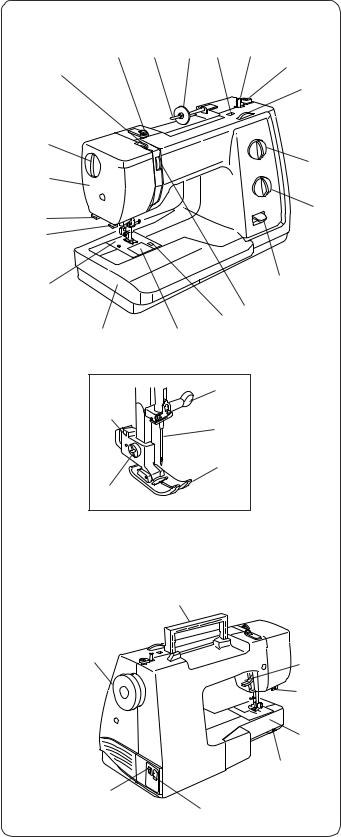
y |
t r e |
w |
u |
|
q |
|
|
|
|
|
@0 |
i |
|
|
o |
|
!9 |
|
|
|
!0 |
|
!8 |
|
|
|
!1 |
|
|
!2 |
|
!7 |
|
!5!6 |
|
!3 |
!4 |
|
@3
@4
@2
@1
@5
|
@6 |
@7 |
#3 |
|
|
|
#2 |
|
#1 |
|
#0 |
@8 |
|
|
@9 |
SECTION 1. KNOW YOUR MACHINE
Names of Parts
q Bobbin winder stopper w Bobbin winder spindle
e Hole for additional spool pin r Spool holder
t Spool pin
y Bobbin winder thread guide u Thread take-up lever
i Foot pressure dial o Face plate
!0Thread cutter
!1Needle threader (Model 2800 only) !2Needle plate
!3Extension table (Accessory storage) !4Bobbin cover plate
!5Bobbin cover plate release button !6Thread tension dial
!7Reverse stitch lever !8Stitch length dial !9Stitch selector dial @0Stitch width dial @1Presser foot
@2Needle
@3Needle clamp screw @4Shank
@5Setscrew
@6Carrying handle @7Flywheel
@8Power switch @9Machine socket #0Drop feed lever #1Free arm
#2Buttonhole lever (Model 2800 only)
#3Presser foot lever
2

q |
|
w |
Standard Accessories |
|
|
||
|
|
|
q Overlock foot C (Model 2800 only) |
e |
|
r |
w Zipper foot E |
|
e Blind hem foot G |
||
|
|
||
|
|
|
r Satin stitch foot F |
|
|
|
t Automatic buttonhole foot R (Model 2800 only) |
t |
y |
u |
y Sliding buttonhole foot J (Model 2600 only) |
|
|
|
u Needles |
|
|
|
i Bobbins |
|
|
|
o Screwdriver |
|
|
|
!0Lint brush |
|
|
|
!1Seam ripper (buttonhole opener) |
i |
|
o |
!2Quilt guide (Model 2800 only) |
|
|
|
!3Spool holder (large) |
|
|
|
!4Spool holder (small) |
|
|
|
!5Additional spool pin |
!0 |
|
!1 |
!6Felt cushion |
|
|
||
|
|
|
!2 |
!3 |
|
|
!4 |
!5 |
!65 |
|
Accessory storage
The standard accessories can be stored in the accessory storage box under the extension table.
Draw out the storage box from the table as shown. q Accessory storage box
q
3
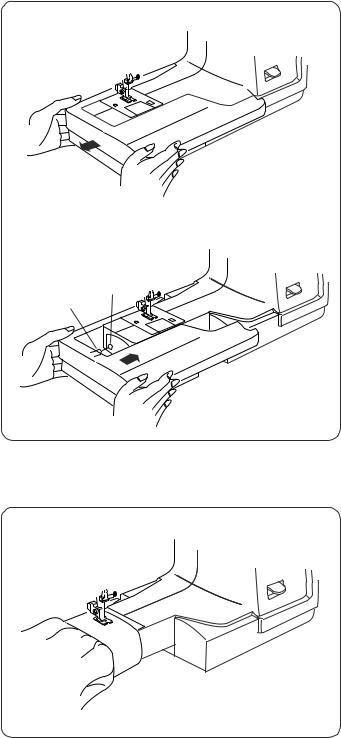
Extension Table
To detach:
Pull the extension table to the left.
|
To attach: |
|
Insert the pin into the hole and push the extension table to |
w |
snap it in place. |
q |
q Pin |
|
w Hole |
Free Arm Sewing
Free arm sewing is used for stitching sleeves, waistbands, pant legs or any other tubular garment.
It is also useful for darning socks or mending knees or elbows.
4
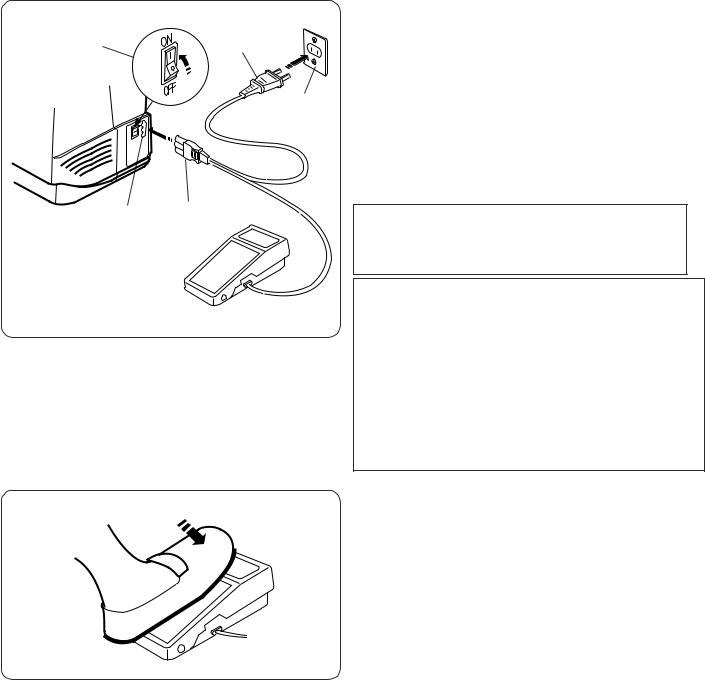
SECTION 2. GETTING READY TO SEW
q |
r |
t
ew
Operating Instructions:
The symbol "O" on the switch indicates the "off" position.
Connecting the Power Supply
z Turn the power switch off.
x Insert the machine plug into the machine socket. c Insert the power supply plug into the wall outlet.
vTurn the power switch on. q Power switch
w Machine plug e Machine socket
r Power supply plug t Wall outlet
NOTE:
Before connecting to the power supply, make sure the voltage shown on the machine conforms to your electrical power.
 WARNING:
WARNING:
While in operation, always keep your eyes on the sewing area, and do not touch any moving parts such as the thread take-up lever, flywheel or needle.
Always turn off the power switch and unplug from the power supply:
-when leaving the machine unattended.
-when attaching or removing parts.
-when cleaning the machine.
Do not place anything on the foot control, otherwise the machine will run intermittently.
Controlling the Sewing Speed
Foot control
Sewing speed can be varied by the foot control.
The harder you depress the foot control, the faster the machine runs.
For an appliance with a polarized plug (one blade wider than the other):
To reduce the risk of electrical shock, this plug is intended to fit in a polarized outlet only one way.
If it does not fit fully in the outlet, reverse the plug. If it still does not fit, contact a qualified electrician to install the proper outlet. Do not modify the plug in any way.
The foot controller Model YC-482J or TJC-150 is used with the sewing machine Models 2600 and 2800 (USA market only).
5
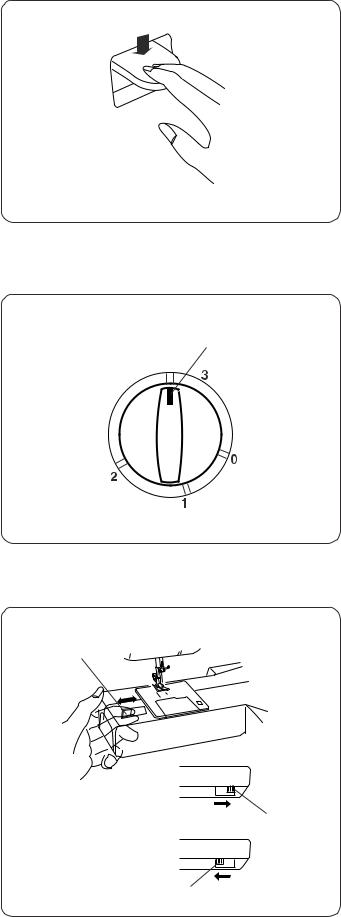
Reverse Stitch Lever
Push the reverse stitch lever down to sew in reverse. The machine will sew in reverse while the lever is pushed.
Foot Pressure Dial
Turn the foot pressure dial to adjust the foot pressure. q The foot pressure dial should be set at “3” for regular
sewing.
Reduce the pressure to “2” for appliqué, cutwork, drawn work and basting.
q Setting mark
|
|
Dropping the Feed Dog |
|
|
The drop feed lever is located underneath the free arm |
q |
|
bed on the backside of the machine. |
|
|
To drop the feed dog, push the lever in the direction of |
|
|
the arrow, as illustrated. |
|
|
To raise the feed dog, push the lever in the direction of |
|
|
the arrow, as illustrated, and turn the flywheel toward |
|
|
you. |
|
|
The feed dog must be up for regular sewing. |
|
|
q Drop feed lever |
|
w |
w Raised position |
|
e Lowered position |
|
|
|
e
6
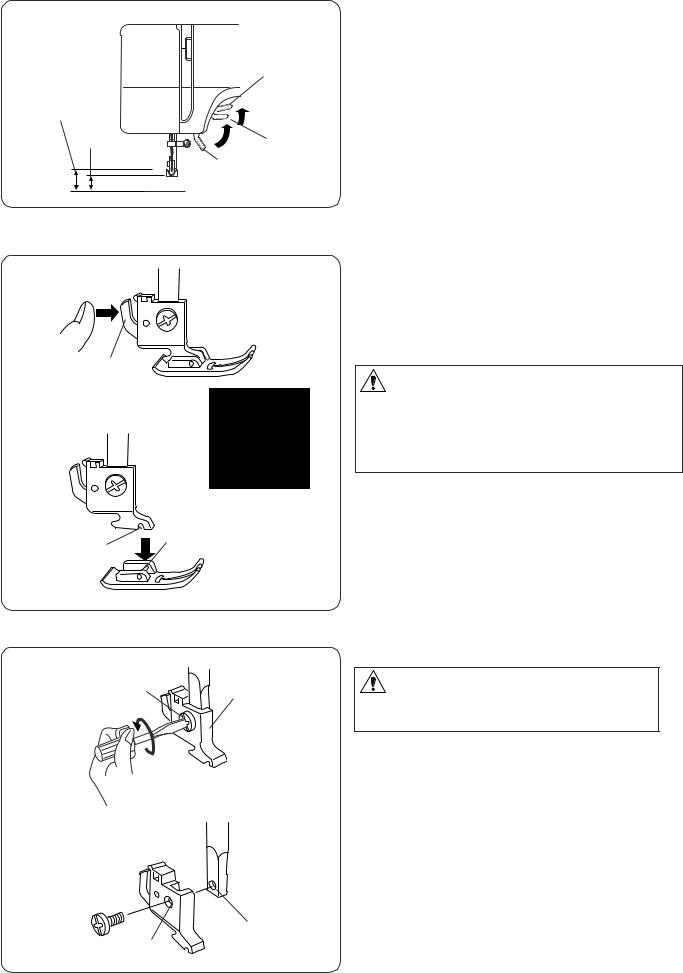
|
Raising and Lowering the Presser Foot |
|
The presser foot lever raises and lowers the presser |
|
foot. |
|
e |
|
You can raise the foot about 1/4" (0.6 cm) higher than |
e |
the raised position for easy removal of the presser foot, |
|
or to place heavy fabric under the foot. |
w |
w |
q Lowered position |
|
||
|
q |
w Raised position |
|
|
e Extra high position |
Changing the Presser Foot
To remove:
Raise the needle to its highest position by turning the flywheel counterclockwise. Raise the presser foot, and press the lever on the back of the shank.
q Lever
q
CAUTION:
Turn OFF the power switch before changing the foot. Always use the proper foot for the selected stitch. The wrong foot can cause the needle to break.
Do not push the lever down to prevent it from being broken.
|
|
To attach: |
|
|
|
Place the desired presser foot, so that the pin on the foot |
|
|
e |
lies just under the groove on the shank. Lower the |
|
w |
presser foot lever to lock the foot in place. |
||
|
|||
|
|
w Groove |
|
|
|
e Pin |
|
|
Removing and Attaching the Shank |
q |
w |
WARNING: |
|
|
Turn OFF the power switch before detaching or |
|
|
attaching the shank. |
|
|
To remove: |
|
|
Remove the setscrew by turning it counterclockwise with |
|
|
a screwdriver and remove the shank. |
|
|
To attach: |
|
|
Match the hole in the shank with the threaded hole in the |
|
|
presser bar. Fit the setscrew into the hole. Tighten the |
|
|
screw by turning it clockwise with a screwdriver. |
|
|
q Setscrew |
|
|
w Shank |
|
|
e Hole |
|
r |
r Threaded hole |
e
7
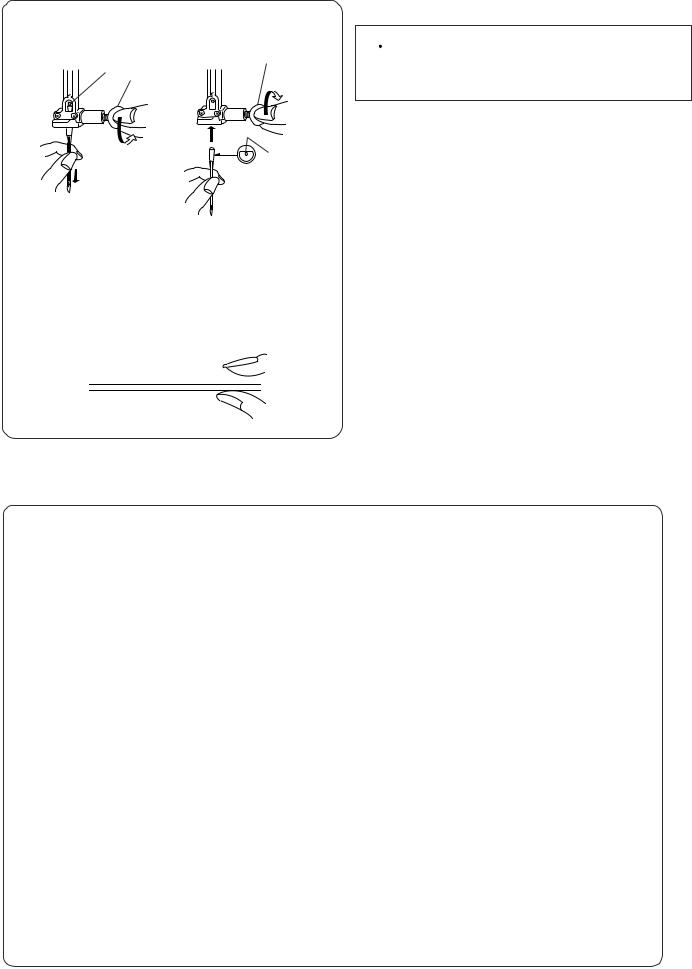
q
w q
e
r 



Changing Needles
 CAUTION:
CAUTION:
Always make sure to turn the power switch off and disconnect the machine from power supply before changing the needle.
Turn off the power switch.
Raise the needle by turning the flywheel and lower the presser foot.
zLoosen the needle clamp screw by turning it counterclockwise.
Remove the needle from the clamp. q Needle clamp screw
xInsert a new needle into the needle clamp with the flat side of the needle to the rear.
When inserting the needle into the needle clamp, push it up against the stopper pin and tighten the needle clamp screw firmly.
w Stopper pin e Flat side
To check needle straightness, place the flat side of the needle onto something flat (a needle plate, glass etc.) The gap between the needle and the flat surface should be consistent.
Never use a blunt needle. r Gap
Needle and Fabric Chart
WEIGHT |
FABRIC |
TYPE of NEEDLE |
NEEDLE SIZE |
||
Very Light |
Chiffon, Georgette, Fine Lace, Organdy |
Universal |
9 (65) |
||
|
Net, Tulle |
Ball Point |
9 (65) |
||
Light |
Batiste, Voile, Lawn, Pure Silk, Crepe de Chine, |
Stretch |
11 (75) |
||
|
Sheer Crepe, Chambray, Handkerchief Linen, |
Universal |
11 (75) |
||
|
Gingham, Challis, Percale, Wool Crepe, Peau de |
|
12 |
(80) |
|
|
Soie, Taffeta, Satin, Silk Surah, Satin-backed |
|
|
|
|
|
Crepe, Qiana |
|
|
|
|
|
|
|
|
||
|
Single Knits, Jersey, Swimwear, and Tricot |
Stretch |
11 (75) |
||
|
|
Ball Point |
11 (75) |
||
|
|
|
|
||
|
Leather, Suede |
Wedge Point |
11 (75) |
||
|
|
Leather |
|
|
|
|
|
|
|
|
|
Medium |
Flannel, Velour, Velvet, Muslin, Velveteen, |
Universal |
14 |
(90) |
|
Poplin, Corduroy, Broadcloth, Linen, Chintz, |
|
|
|
||
|
Gabardine, Felt, Terry, Burlap, Quilted Fabrics |
|
|
|
|
|
|
|
|
|
|
|
Double Knits, (synthetic and natural) Stretch |
Ball Point |
14 |
(90) |
|
|
Velour, Stretch Terry, Sweater Knits |
|
|
|
|
|
|
|
|
|
|
|
Leather, Vinyl, Suede |
Wedge Point |
14 |
(90) |
|
|
|
Leather |
|
|
|
|
|
|
|
|
|
Heavy |
Denim, Sailcloth, Ticking |
Denim |
16 |
(100) |
|
|
|
|
|
||
Double Faced Wool, Heavy Coating, Fake Fur, |
Universal |
16 |
(100) |
||
|
|||||
|
Drapery Fabrics |
|
|
|
|
|
|
|
|
|
|
|
Leather, Suede |
Wedge Point |
16 |
(100) |
|
|
|
Leather |
18 |
(110) |
|
Very Heavy |
Canvas, Duck, Upholstery Fabrics |
Universal |
16 |
(100) |
|
|
Topstitching for Special Finishes |
Topstitching |
14 |
(90) |
|
8
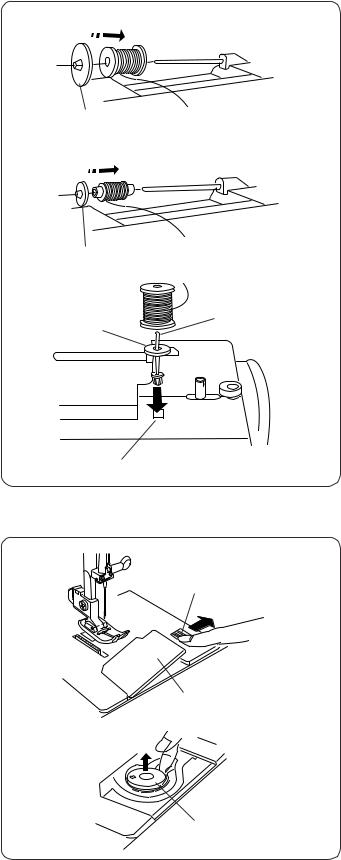
|
Winding the Bobbin |
(A) |
Setting the spool |
|
Place a spool of thread on the spool pin with the thread |
|
coming off the spool as illustrated. |
q |
A: Press the large spool holder firmly against the spool |
|
of thread. |
|
q Large spool holder |
(B) |
B: For a small spool, use the small spool holder. |
|
|
|
w Small spool holder |
w |
|
|
Additional spool pin |
e |
The additional spool pin is for bobbin winding without |
unthreading the machine. |
|
r |
Insert the additional spool pin into the hole. |
|
|
|
Place the felt cushion and thread on the pin. |
|
e Additional spool pin |
|
r Felt cushion |
|
t Spool pin hole |
t
|
Removing the bobbin |
|
q |
z Push the bobbin cover plate release button to the |
|
right and remove the cover plate. |
||
|
||
|
q Bobbin cover plate release button |
|
|
w Bobbin cover plate |
w
x Lift out the bobbin. e Bobbin
e
9
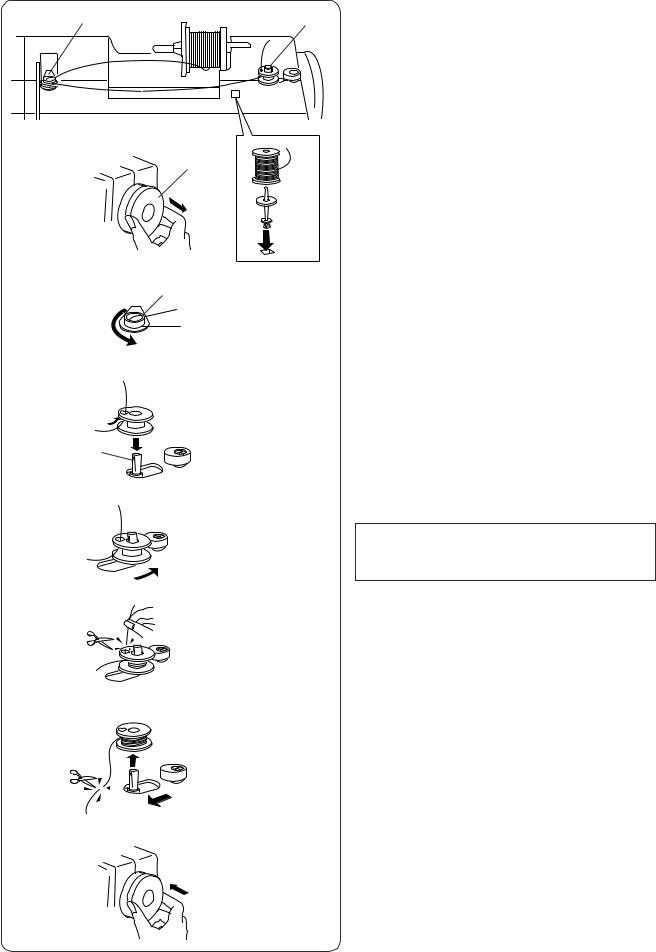
w |
Winding the bobbin |
e |
z |
q |
z Pull out the flywheel to disengage the clutch. |
|
||
|
|
q flywheel |
|
w |
x |
x Draw the thread from the spool. Guide the thread |
|
around the bobbin winder thread guide. |
|
w Bobbin winder thread guide |
c |
|
c Thread through the hole in the bobbin from the inside |
|
|
to the outside. |
|
e |
Put the bobbin on the bobbin winder spindle with the |
|
free end of the thread coming out at the top. |
|
|
|
|
|
|
e Bobbin winder spindle |
v |
|
v Push the bobbin to the right. |
|
|
NOTE: |
|
|
Do not move the bobbin winder spindle while the |
|
|
machine is running. |
b |
|
b With the free end of the thread held in your hand, |
|
|
depress the foot control. Stop the machine when the |
|
|
bobbin has been wound a few layers, and cut the |
|
|
thread close to the bobbin. |
n |
|
n Depress the foot control again. When the bobbin is |
|
|
fully wound, it will stop automatically. |
|
|
Return the bobbin winder to its original position by |
|
|
moving the spindle to the left, and cut the thread as |
|
|
illustrated. |
m |
|
m Push in the flywheel to engage the clutch. |
10
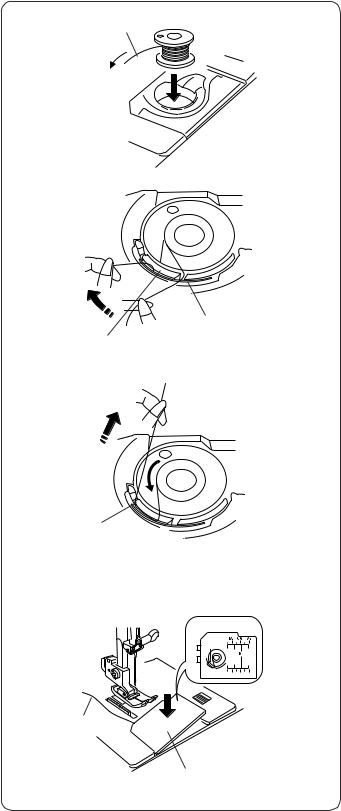
|
Inserting the bobbin |
|
q |
z |
z Place the bobbin in the bobbin case with the thread |
|
running off as illustrated. |
|
q Thread |
x |
x Guide the thread into the front notch on the front side |
|
of the bobbin case. Draw the thread to the left, sliding |
|
it between the tension spring blades. |
|
w Front notch |
|
e Tension spring blade |
|
w |
|
e |
c |
c Continue to draw the thread lightly until the thread |
|
slips into the side notch. |
|
r Side notch |
r
v |
v Pull out about 4” (10 cm) of thread. Attach the bobbin |
|
cover plate. Refer to the chart on the bobbin cover |
|
plate for proper threading. |
|
t Thread |
|
y Bobbin cover plate |
t
y
11

z
c
v |
x |
|
|
b |
q |
|
z |
|
w |
x
r
e
c
t
v b
y
Threading the Machine
To set the needle thread:
Raise the thread take-up lever to the highest position by turning the flywheel.
Raise the presser foot.
 WARNING:
WARNING:
Turn OFF the power switch before threading the needle.
zDraw the thread from the spool and pass it under the thread guide. Then draw it down along the right channel.
q Thread guide w Right channel
xDraw the thread up around the bottom of the thread guide plate.
Pull the thread up along the left channel e Thread guide plate
r Left channel
cFirmly draw the thread from right to left over the thread take-up lever and down into the take-up lever eye.
t Thread take-up lever
vDraw the thread down along the left channel and slip the thread behind the needle bar thread guide from the left.
y Needle bar thread guide
bPass the thread through the needle eye from the front or use the needle threader (refer to the next page).
12
